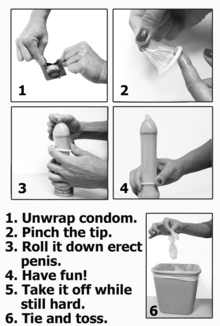Precautions
Solitary sex
Known as autoeroticism, solitary sexual activity is relatively safe. Masturbation, the simple act of stimulating one's own genitalia, is safe so long as contact is not made with other people's bodily fluids. Some activities, such as phone sex and cybersex, that allow for partners to engage in sexual activity without being in the same room, eliminate the risks involved with exchanging bodily fluids.
Non-penetrative sex
Barrier protection
Various protective devices are used to avoid contact with blood, vaginal fluid, semen or other contaminant agents (like skin, hair and shared objects) during sexual activity. Sexual activity using these devices is called protected sex.
- Condoms cover the penis during sexual activity. They are most frequently made of latex, and can also be made out of synthetic materials including polyurethane.
- Female condoms are inserted into the vagina prior to intercourse. Male and female condoms shouldn't be used together, as the friction of the two rubbing together can compromise the effectiveness of both.
- A dental dam (originally used in dentistry) is a sheet of latex used for protection when engaging in oral sex. It is typically used as a barrier between the mouth and the vulva during cunnilingus or between the mouth and the anus during anal–oral sex.
- Medical gloves made out of latex, vinyl, nitrile, or polyurethane may be used as a makeshift dental dam during oral sex, or to protect the hands during sexual stimulation, such as masturbation. Hands may have invisible cuts on them that may admit pathogens or contaminate the other body part or partner.
- Another way to protect against pathogen transmission is the use of protected or properly cleaned dildos and other sex toys. If a sex toy is to be used in more than one orifice or partner, a condom can be used over it and changed when the toy is moved.
When latex barriers are used, oil-based lubrication can break down the structure of the latex and remove the protection it provides.
Condoms (male or female) are used to protect against STIs, and used with other forms of contraception to improve contraceptive effectiveness. For example, simultaneously using both the male condom and spermicide (applied separately, not pre-lubricated) is believed to reduce perfect-use pregnancy rates to those seen among implant users. However, if two condoms are used simultaneously (male condom on top of male condom, or male condom inside female condom), this increases the chance of condom failure.
Proper use of barriers, such as condoms, depends on the cleanliness of surfaces of the barrier, handling can pass contamination to and from surfaces of the barrier unless care is taken.
Studies of latex condom performance during use reported breakage and slippage rates varying from 1.46% to 18.60%. Condoms must be put on before any bodily fluid could be exchanged, and they must be used also during oral sex.
Female condoms are made of two flexible polyurethane rings and a loose-fitting polyurethane sheath. According to laboratory testing, female condoms are effective in preventing the leakage of body fluids and therefore the transmission of STIs and HIV. Several studies show that between 50% and 73% of women who have used this type of condoms during intercourse find them as or more comfortable than male condoms. On the other hand, acceptability of these condoms among the male population is somewhat less, at approximately 40%. Because the cost of female condoms is higher than male condoms, there have been studies carried out with the aim of detecting whether they can be reused. Research has shown that structural integrity of polyurethane female condoms is not damaged during up to five uses if it is disinfected with water and household bleach. However, regardless of this study, specialists still recommend that female condoms be used only once and then discarded.
Pre-exposure prophylaxis
Currently, the only drug which any health organization recommends for PrEP is a drug combination of tenofovir/emtricitabine, which is licensed under the brand name Truvada by Gilead Sciences. The Centers for Disease Control says that "PrEP is a powerful HIV prevention tool and can be combined with condoms and other prevention methods to provide even greater protection than when used alone. But to be most effective people who use PrEP must take the drug every day and see their health care provider for follow-up every 3 months."
PrEP is recommended for use with condoms, so that each method can compensate for essential or casual efficacy deficits of the other. Contrary to medical best practice, PrEP is sometimes used by those who do not wish to use condoms or who intend to have condomless sex. There are social groups which both support and oppose the use of PrEP.
Other precautions
Acknowledging that it is usually impossible to have entirely risk-free sex with another person, proponents of safe sex recommend that some of the following methods be used to minimize the risks of STI transmission and unwanted pregnancy.
- Immunization against various viral infections that can be transmitted sexually. The most common vaccines are HPV vaccine, which protects against the most common types of human papillomavirus that cause cervical cancer, and the Hepatitis B vaccine. Immunization before initiation of sexual activity increases effectiveness.
- Male circumcision and HIV: Some research has suggested that male circumcision can reduce the risk of HIV infection in some countries. The World Health Organization cites the procedure as a measure against the transmission of HIV between women and men; some African studies have found that circumcision can reduce the rate of transmission of HIV to men by up to 60%. Some advocacy groups dispute these findings. In sub-Saharan Africa, at least, condom use and behavior change programs are estimated to be more efficient and much more cost-effective than surgical procedures such as circumcision.
- Periodic STI testing has been used to reduce STIs in Cuba and among pornographic film actors. Cuba implemented a program of mandatory testing and quarantine early in the AIDS epidemic. In the US pornographic film industry, many production companies will not hire actors without tests for Chlamydia, HIV and Gonorrhea that are no more than 30 days old-and tests for other STIs no more than 6 months old. AIM Medical foundation claims that program of testing has reduced the incidence of sexually transmitted infection to 20% of that of the general population. Douching with soap and water disrupts the vaginal flora and might increase risk of infection.
- Monogamy or polyfidelity, practiced faithfully, is very safe (as far as STIs are concerned) when all partners are non-infected. However, many monogamous people have been infected with sexually transmitted diseases by partners who are sexually unfaithful, have used injection drugs, or were infected by previous sexual partners; the same risks apply to polyfidelitous people, who face higher risks depending on how many people are in the polyfidelitous group.
- For those who are not monogamous, reducing the number of one's sexual partners, particularly anonymous sexual partners, may also reduce one's potential exposure to STIs. Similarly, one may restrict one's sexual contact to a community of trusted individuals—this is the approach taken by some pornographic actors and other non-monogamous people.
- When selecting a sexual partner, some characteristics can increase the risks for contracting sexually transmitted diseases. These include an age discordance of more than five years; having an STI in the past year; problems with alcohol; having had sex with other people in the past year.
- Communication with one's sexual partner(s) makes for greater safety. Before initiating sexual activities, partners may discuss what activities they will and will not engage in, and what precautions they will take. This can reduce the chance of risky decisions being made "in the heat of passion".
- If a person is sexually active with a number of partners, regular sexual health check-ups by a doctor, and on noticing unusual symptoms seeking prompt medical advice; HIV and other infectious agents can be either asymptomatic or involve nonspecific symptoms which on their own can be misdiagnosed. Due to the emergence of antibiotic resistant strains of pathogens that can be transmitted during sex, treatment failure is possible and additional and different medications may be necessary.
Limitations
While the use of condoms can reduce transmission of HIV and other infectious agents, it does not do so completely. One study has suggested condoms might reduce HIV transmission by 85% to 95%; effectiveness beyond 95% was deemed unlikely because of slippage, breakage, and incorrect use. It also said, "In practice, inconsistent use may reduce the overall effectiveness of condoms to as low as 60–70%".
During each act of anal intercourse, the risk of the receptive partner acquiring HIV from HIV seropositive partners not using condoms is about 1 in 120. Among people using condoms, the receptive partner's risk declines to 1 in 550, a four- to fivefold reduction. Where the partner's HIV status is unknown, "Estimated per-contact risk of protected receptive anal intercourse with HIV-positive and unknown serostatus partners, including episodes in which condoms failed, was two thirds the risk of unprotected receptive anal intercourse with the comparable set of partners."
In March 2013, Bill Gates offered a US$100,000 grant through his foundation for a condom design that "significantly preserves or enhances pleasure" to encourage more males to adopt the use of condoms for safer sex. The grant information states: “The primary drawback from the male perspective is that condoms decrease pleasure as compared to no condom, creating a trade-off that many men find unacceptable... Is it possible to develop a product without this stigma, or better, one that is felt to enhance pleasure?” The project has been named the "Next Generation Condom". After a few promising prototypes were made with the grant, the condom designers found it takes years and millions of dollars to get them approved by the FDA, so no new product will be ready in the near future.
Ineffective methods
Most methods of contraception, except for certain forms of "outercourse" and the barrier methods, are not effective at preventing the spread of STIs. This includes the birth control pills, vasectomy, tubal ligation, periodic abstinence and all non-barrier methods of pregnancy prevention.
Abstinence
Sexual abstinence is sometimes promoted as a way to avoid the risks associated with sexual contact, though STIs may also be transmitted through non-sexual means, or by involuntary sex. HIV may be transmitted through contaminated needles used in tattooing, body piercing, or injections. Medical or dental procedures using contaminated instruments can also spread HIV, while some health-care workers have acquired HIV through occupational exposure to accidental injuries with needles. Evidence does not support the use of abstinence only sex education. Abstinence-only education programs have been found to be ineffective in decreasing rates of HIV infection in the developed world and unplanned pregnancy.
Anal sex
Unprotected anal penetration is a high risk activity, regardless of sexual orientation. Anal sex is a higher risk activity than vaginal intercourse because the thin tissues of the anus and rectum can be easily damaged. Slight injuries can allow the passage of bacteria and viruses, including HIV. This includes by the use of anal toys. Condoms may be more likely to break during anal sex than during vaginal sex, increasing the risk.
Precautions
Anal sex should be avoided by couples in which one of the partners has been diagnosed with an STI until the treatment has proven to be effective.
Sex toys
Putting a condom on a sex toy provides better sexual hygiene and can help to prevent transmission of infections if the sex toy is shared, provided the condom is replaced when used by a different partner. Some sex toys are made of porous materials, and pores retain viruses and bacteria, which makes it necessary to clean sex toys thoroughly, preferably with use of cleaners specifically for sex toys. Glass is non-porous and medical grade glass sex toys more easily sterilized between uses.














0 nhận xét:
Đăng nhận xét